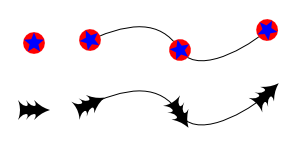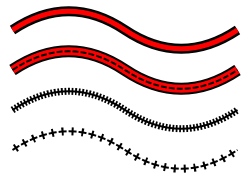| Inkscape » Attributes » Stroke Style |    |
|---|
The Stroke style tab has options to change the style of an object's path. This includes the stroke width, Join style, Cap style, Dash Pattern, and Markers.

Stroke width can be changed by the Width entry box. The units are specified by the drop-down menu on the right.
![[Note]](../images/admons/note.png) | Note |
|---|---|
If you want the line width to transform with an object, you must
toggle on this option using the
|
The Join style is how two lines meeting at a corner should be joined together. The options are:
![]() Miter join.
Miter join.
![]() Round join.
Round join.
![]() Bevel join.
Bevel join.
The different Join styles are shown in the figure following.

When the Miter option is selected, the length of the projection can become quite long if the two lines intersect at a small angle. In this case, it may be preferable to use the Bevel style. The Miter limit controls the point at which a Miter join automatically is converted to a Bevel join. If the distance from the inner intersection point to the tip of the triangle ("m" in the following figure) measured in stroke widths is more than the Miter limit, the join will be drawn in the Bevel style.

![[Note]](../images/admons/note.png) | Note |
|---|---|
The bounding box is determined by assuming that the Join style is Round. |
The Cap style determines how the end of a line is drawn. The options are:
![]() Butt cap.
Butt cap.
![]() Round cap.
Round cap.
![]() Square cap.
Square cap.
The different Cap styles are shown in the figure below.

![[Note]](../images/admons/note.png) | Note |
|---|---|
The bounding box is determined by assuming the Cap style is Round. |
A wide selection of Dash patterns are available from the drop-down Dash menu. The patterns scale with the stroke width.
![[Note]](../images/admons/note.png) | Note |
|---|---|
Each Dash takes on the Cap style as shown in the figure below. |

The entry box next to the Dash menu is for the Dash offset. The offset shifts the Dash pattern parallel to the path. The units are in stroke width.
Markers are objects like arrow heads placed along a path. Different Markers can be specified for the start, middle, and end of a path. Middle Markers are placed at the location of every non-end node.
New in v0.46:
A custom Marker can be created by selecting the object or objects that you wish to use as a Marker and then using the → command. The selected objects will disappear and a new entry will appear in the Marker pull-down menus of the Fill and Stroke dialog. The Marker is created assuming a horizontal orientation for the path. The point of attachment to a node is the center of the bounding box for the Marker. Warning: While the marker will display fine in Inkscape, only a fourth of it will be displayed in most other SVG renderers. Adding the attribute style="overflow:visible" to the Marker definition will fix the problem (Bug). Note, that custom Markers can be added to Inkscape; see the section called “Custom Markers” in Chapter 20, Customization.

Note: The → procedure is a bit buggy. The new Marker may not show up in the list until another Marker is applied to the path. If multiple objects are converted, the z-order is reversed. Group the objects first to avoid this problem.
Two problems exist with Markers. The first is that Markers do not take the color of the stroke. This can be worked around by using the Color Markers to Match Stroke effect, by editing the SVG file with the XML Editor, or adding a custom, pre-colored Marker. An alternative solution is to convert the path with the Markers to a path ( → (Shift+Ctrl+C)). This creates a Group with the Markers converted to separate objects, which can be colored independently.
The second problem is that Markers scale with line width. The line width had to be reduced in the above figure for the scissors examples, to give the scissors a reasonable size. Again, one could edit the SVG file to adjust the Marker size.
![[Tip]](../images/admons/tip.png) | Tip |
|---|---|
To place middle Markers evenly along a path you need to have
evenly spaced nodes. For straight horizontal and vertical lines,
nodes can be distributed evenly using the Align and Distribute
dialog. To add just one node halfway between two existing nodes
click on the Insert
|
Another thing to note is that Markers are included in the Visual bounding box calculation.
A complex Stroke can be created by overlaying two or more paths with different Stroke attributes. The easiest way to make exact copies of a path is to use the → (Ctrl+D) command.
If one uses Clones of a path ( → → (Alt+D)), then one can adjust the original path at a later time and all the Clones will change too. This requires unsetting the Stroke attributes of the original path (use the XML editor to unset the Stroke width). Since the original path's attributes are unset, it will not be visible and cannot be used as part of the visible Stroke.

© 2005-2008 Tavmjong Bah. | Get the book. |